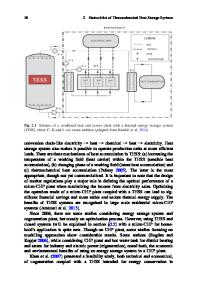Paper title: thermochemical heat storage behavior of ZnSO 4 .7H 2 O under low-temperature
- PDF / 750,667 Bytes
- 11 Pages / 595.276 x 790.866 pts Page_size
- 65 Downloads / 312 Views
ORIGINAL
Paper title: thermochemical heat storage behavior of ZnSO4.7H2O under low-temperature Ata Ur Rehman 1,2 & Muhammad Khan 3,4
&
Zheng Maosheng 1 & Ahsen Riaz Khan 1 & Asif Hayat 5
Received: 29 November 2019 / Accepted: 24 October 2020 # Springer-Verlag GmbH Germany, part of Springer Nature 2020
Abstract Thermochemical heat storage materials for space heating applications such as, ZnSO4 offer high energy storage density, low cost and clean mean of long-term solar energy storage. Herein, we studied the ZnSO4 hydrated salt as potential heat storage material at low temperature and furthermore observed the impact of temperature and concentration on the dehydration/hydration process and enthalpy. The thermal behavior of ZnSO4•7H2O was investigated by applying various dehydration temperatures. The results showed that 85% of water loosed at 100 °C temperature, which released 699 J/g (1.37 GJ/m3) in the dehydration process. The hydration process of ZnSO4.7H2O at 100 °C recovered 541 J/g enthalpies, which delivered 1.1 GJ/m3. Similarly, the dehydration result obtained at 150 °C was the same as showed at 100 °C. However, the enthalpy of hydration was 20% less than prior. The XRD result showed that at higher temperatures agglomeration appeared followed by Van der Waals forces which affect the hydration rate. The result of good cyclability and larger water sorption performance of ZnSO4 make them a promising and suitable for heat storage in space heating application, which can be used as thermochemical heat storage material for thermal storage devices. Keywords Heat storage . Renewable energy . Hydration and dehydration . Zinc sulfate heptahydrate
1 Introduction The expanded interest in energy, the ascent in the cost of fuel related to the consumption of petroleum derivatives, and the impact of greenhouse gasses on our climatic needs replacement * Ata Ur Rehman [email protected] * Muhammad Khan [email protected] 1
Institute for Energy Transmission Technology and Application, School of Chemical Engineering, Northwest University, Xi’an, Shaanxi, People’s Republic of China
2
Department of Chemistry, Bacha Khan University, Charsadda, Pakistan
3
School of Materials Science and Engineering, Northwestern Polytechnical University, Xi’an 710072, Shaanxi, People’s Republic of China
4
Department of Chemistry, University of Okara, Renala Khurd, Okara, Punjab, Pakistan
5
College of Chemistry, Fuzhou University, Fuzhou, People’s Republic of China
of non-sustainable power sources to sustainable power sources which are more energy efficient and environment-friendly in the procedure as compared to carbon-based systems. Previous studies suggested that the required percentage of thermal energy in the residential area was in between 40 and 50% of the final energy [1]. Since to avoid carbon-based technologies, the required amount of space heat energy can be covered through renewable energy sources such as tidal energy [2], wind energy [1], and solar energy [2–4]. Among these sources, solar energy application is a
Data Loading...











